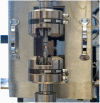Evaluation of the Effect of Selected Physiological Fluid Contaminants on the Mechanical Properties of Selected Medium-Viscosity PMMA Bone Cements
- PMID: 35329650
- PMCID: PMC8951357
- DOI: 10.3390/ma15062197
Evaluation of the Effect of Selected Physiological Fluid Contaminants on the Mechanical Properties of Selected Medium-Viscosity PMMA Bone Cements
Abstract
Revision surgeries several years after the implantation of the prosthesis are unfavorable from the patient's point of view as they expose him to additional discomfort, to risk of complications and are expensive. One of the factors responsible for the aseptic loosening of the prosthesis is the gradual degradation of the cement material as a result of working under considerable loads, in an aggressive environment of the human body. Contaminants present in the surgical field may significantly affect the durability of the bone cement and, consequently, of the entire bone-cement-prosthesis system. The paper presents the results of an analysis of selected mechanical properties of two medium-viscosity bone cements DePuy CMW3 Gentamicin and Heraeus Palamed, for the samples contaminated with saline and blood in the range of 1-10%. The results obtained for compressive strength and modulus of elasticity were subjected to statistical analysis, which estimated the nature of changes in these parameters depending on the amount and type of contamination and their statistical significance.
Keywords: blood; bone cement; compressive strength; contamination; mechanical parameters; modulus of elasticity; saline.
Conflict of interest statement
The authors declare no conflict of interest. The funders had no role in the design of the study; in the collection, analyses, or interpretation of data; in the writing of the manuscript; or in the decision to publish the results.
Figures







References
-
- Krakowski P., Karpiński R., Maciejewski R., Jonak J., Jurkiewicz A. Short-Term Effects of Arthroscopic Microfracturation of Knee Chondral Defects in Osteoarthritis. Appl. Sci. 2020;10:8312. doi: 10.3390/app10238312. - DOI
-
- Krakowski P., Nogalski A., Jurkiewicz A., Karpiński R., Maciejewski R., Jonak J. Comparison of Diagnostic Accuracy of Physical Examination and MRI in the Most Common Knee Injuries. Appl. Sci. 2019;9:4102. doi: 10.3390/app9194102. - DOI
Grants and funding
LinkOut - more resources
Full Text Sources

